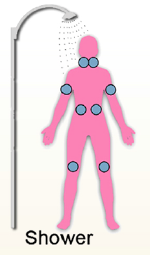
UC Davis - Post Shower Research
Objective: Determine if the M-Vac™ is capable of collecting male saliva from a female's skin after showering. Many female victims hesitate to report sexual assault, and, in some instances, shower before making a final decision. Showering can easily remove saliva from skin and can make collection of salivary DNA difficult. This project aims to explore the amount of salivary DNA that can be obtained using the M-Vac™ compared to traditional swab methods with the location of the saliva being known.
 Methods: Apply male saliva in four locations, right and left, on the neck, upper arm, abdomen and lower thighs of the female victim. Apply the saliva in 50 microliters quantities. Wait 15 minutes for the saliva to dry. Go about normal activities for four hours, shower and return for collections. Use the M-Vac™ to collect from the right side locations and the swab to collect from the left side locations.
Methods: Apply male saliva in four locations, right and left, on the neck, upper arm, abdomen and lower thighs of the female victim. Apply the saliva in 50 microliters quantities. Wait 15 minutes for the saliva to dry. Go about normal activities for four hours, shower and return for collections. Use the M-Vac™ to collect from the right side locations and the swab to collect from the left side locations.
Extraction/Analysis: Extract the DNA using the QIAmp® DNA Investigator Kit (Qiagen). DNA quantification was done with Quantifiler Duo® Kit (ABI). DNA amplification was done with AmpFISTER® Identifiler® PCR Kit and YSTR Kit (ABI).
Results: There was no statistical difference between the quantities collected by the M-Vac™ and the swab.
Conclusions: In some cases, a sexual assault victim will shower before they seek out a forensic exam. In addition, the victim does not always remember where the perpetrator has touched them. The traditional swab technique is limited to a small surface area, but the M-Vac™ can sample large regions of the body. In this study, the saliva location was known, potentially giving the swab an over-representation in the results. When the saliva location is unknown, the M-Vac™ would be more effective.
References: 2014 AAFS Poster - Comparing the M-Vac to Standard DNA Collection Methods for Large Surface Areas, Katie L. Caswell; Marc J. Wander; Shane E. Williams; Ruth E. Ballard, Ph.D.; Cassandra D. Calloway, Ph.D.; Christopher J. Hopkins, M.S.; William M. Green, M.D.; Sree Kanthaswamy, Ph.D.; and Edward A. Panacek, M.D.; University of California at Davis, Forensic Science Program; Sacramento State University, California Clinical Forensic Medical Training Center.